Reflection on Cultural Safety: Healthcare for Aboriginals
VerifiedAdded on 2021/04/21
|8
|1858
|363
Essay
AI Summary
This reflective essay explores the concept of cultural safety within healthcare, with a specific focus on the Aboriginal and Torres Strait Islander (TSI) populations. The author, an international student, reflects on their learning journey, contrasting their experiences with the cultural challenges faced by Aboriginal and TSI people in Australia. The essay delves into the historical context, power imbalances, and systemic issues contributing to health disparities. Key principles of cultural safety, including economic, social, and historical influences, are examined. The author discusses their personal feelings, evaluations, and analyses of the subject matter, highlighting the importance of cultural awareness, sensitivity, and empowerment in nursing practice. The essay emphasizes the need for healthcare providers to be responsive to cultural differences and address conscious and unconscious racism to improve health outcomes for Aboriginal and TSI communities. The author concludes with an action plan for fostering cultural safety in their future nursing career.
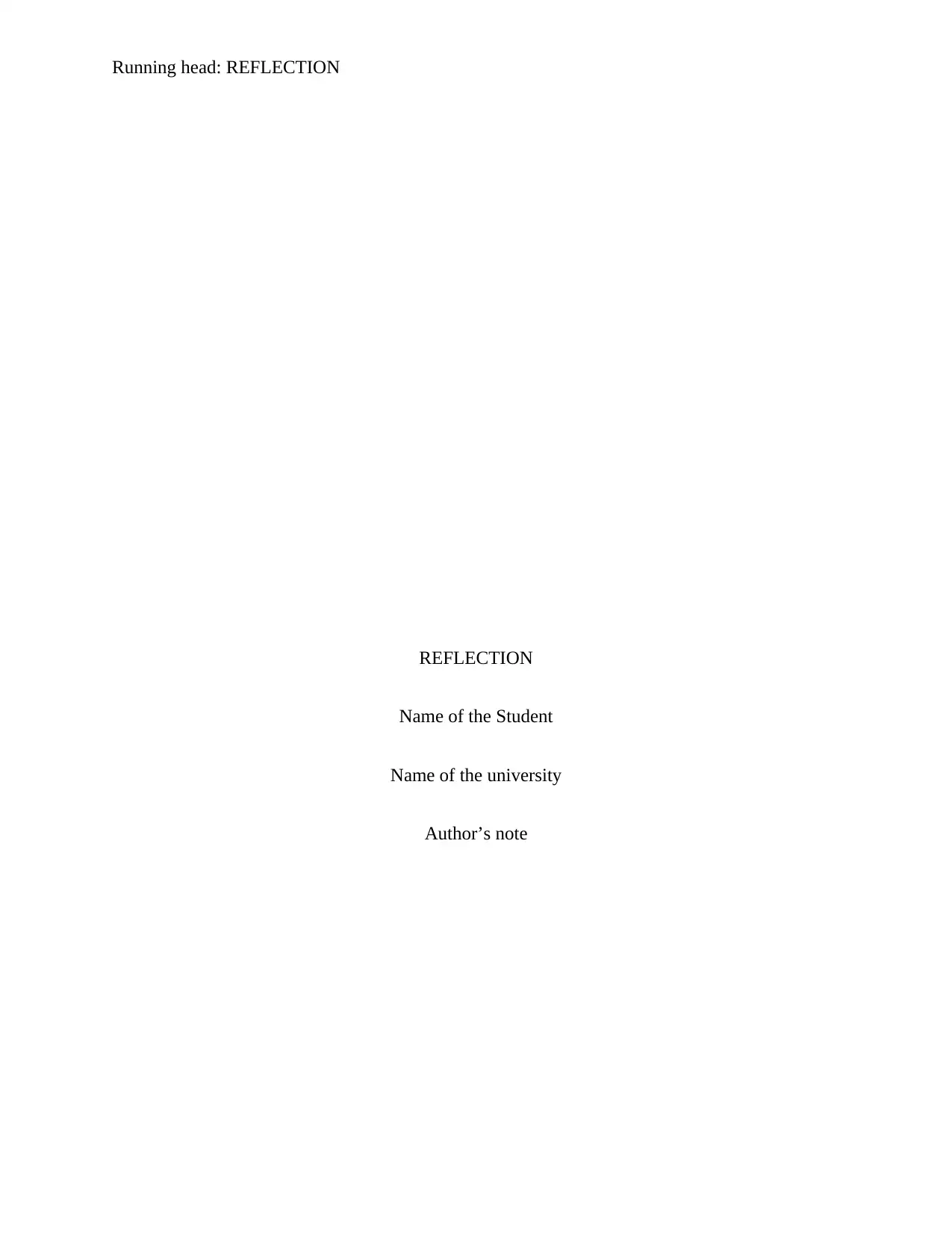
Running head: REFLECTION
REFLECTION
Name of the Student
Name of the university
Author’s note
REFLECTION
Name of the Student
Name of the university
Author’s note
Paraphrase This Document
Need a fresh take? Get an instant paraphrase of this document with our AI Paraphraser
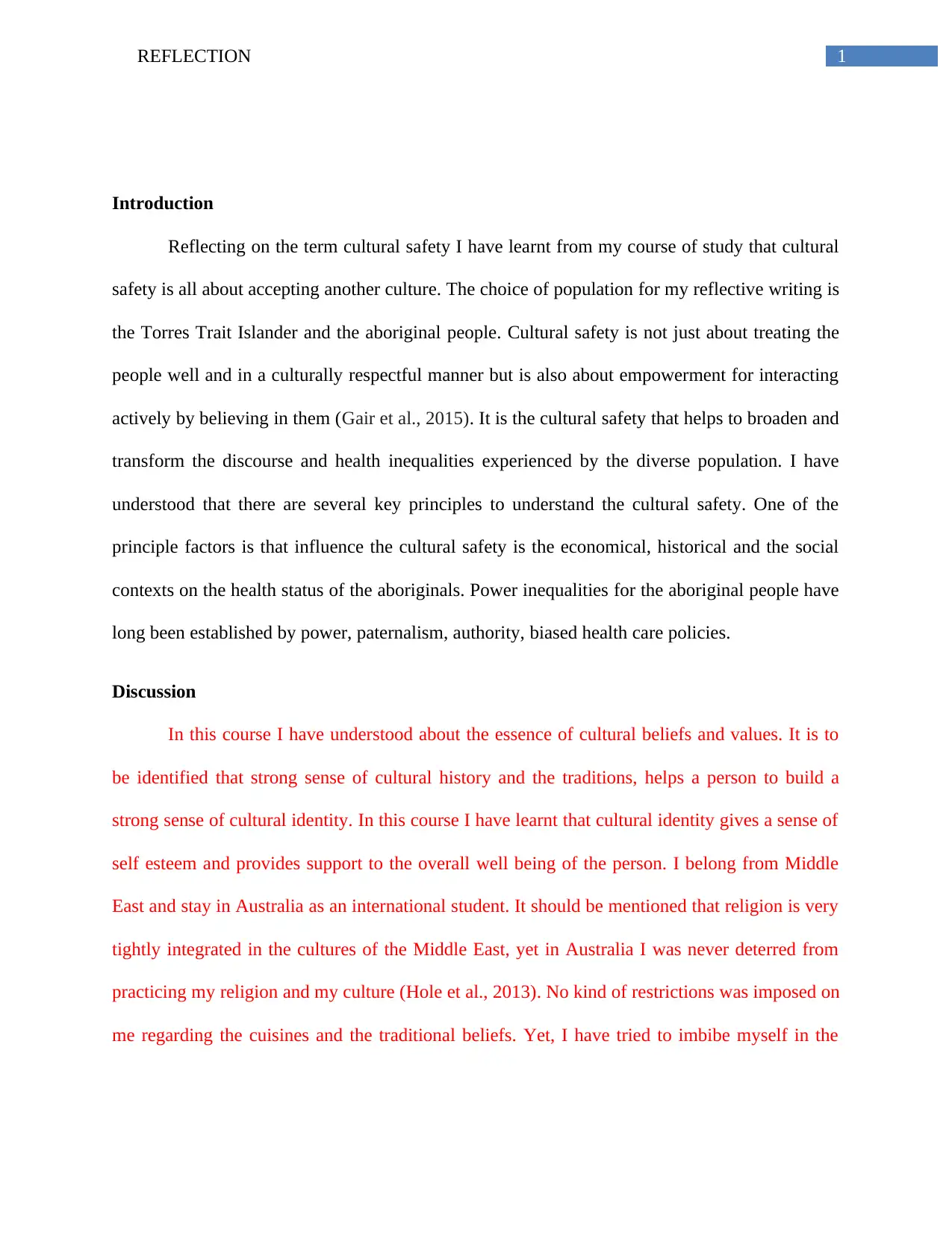
1REFLECTION
Introduction
Reflecting on the term cultural safety I have learnt from my course of study that cultural
safety is all about accepting another culture. The choice of population for my reflective writing is
the Torres Trait Islander and the aboriginal people. Cultural safety is not just about treating the
people well and in a culturally respectful manner but is also about empowerment for interacting
actively by believing in them (Gair et al., 2015). It is the cultural safety that helps to broaden and
transform the discourse and health inequalities experienced by the diverse population. I have
understood that there are several key principles to understand the cultural safety. One of the
principle factors is that influence the cultural safety is the economical, historical and the social
contexts on the health status of the aboriginals. Power inequalities for the aboriginal people have
long been established by power, paternalism, authority, biased health care policies.
Discussion
In this course I have understood about the essence of cultural beliefs and values. It is to
be identified that strong sense of cultural history and the traditions, helps a person to build a
strong sense of cultural identity. In this course I have learnt that cultural identity gives a sense of
self esteem and provides support to the overall well being of the person. I belong from Middle
East and stay in Australia as an international student. It should be mentioned that religion is very
tightly integrated in the cultures of the Middle East, yet in Australia I was never deterred from
practicing my religion and my culture (Hole et al., 2013). No kind of restrictions was imposed on
me regarding the cuisines and the traditional beliefs. Yet, I have tried to imbibe myself in the
Introduction
Reflecting on the term cultural safety I have learnt from my course of study that cultural
safety is all about accepting another culture. The choice of population for my reflective writing is
the Torres Trait Islander and the aboriginal people. Cultural safety is not just about treating the
people well and in a culturally respectful manner but is also about empowerment for interacting
actively by believing in them (Gair et al., 2015). It is the cultural safety that helps to broaden and
transform the discourse and health inequalities experienced by the diverse population. I have
understood that there are several key principles to understand the cultural safety. One of the
principle factors is that influence the cultural safety is the economical, historical and the social
contexts on the health status of the aboriginals. Power inequalities for the aboriginal people have
long been established by power, paternalism, authority, biased health care policies.
Discussion
In this course I have understood about the essence of cultural beliefs and values. It is to
be identified that strong sense of cultural history and the traditions, helps a person to build a
strong sense of cultural identity. In this course I have learnt that cultural identity gives a sense of
self esteem and provides support to the overall well being of the person. I belong from Middle
East and stay in Australia as an international student. It should be mentioned that religion is very
tightly integrated in the cultures of the Middle East, yet in Australia I was never deterred from
practicing my religion and my culture (Hole et al., 2013). No kind of restrictions was imposed on
me regarding the cuisines and the traditional beliefs. Yet, I have tried to imbibe myself in the
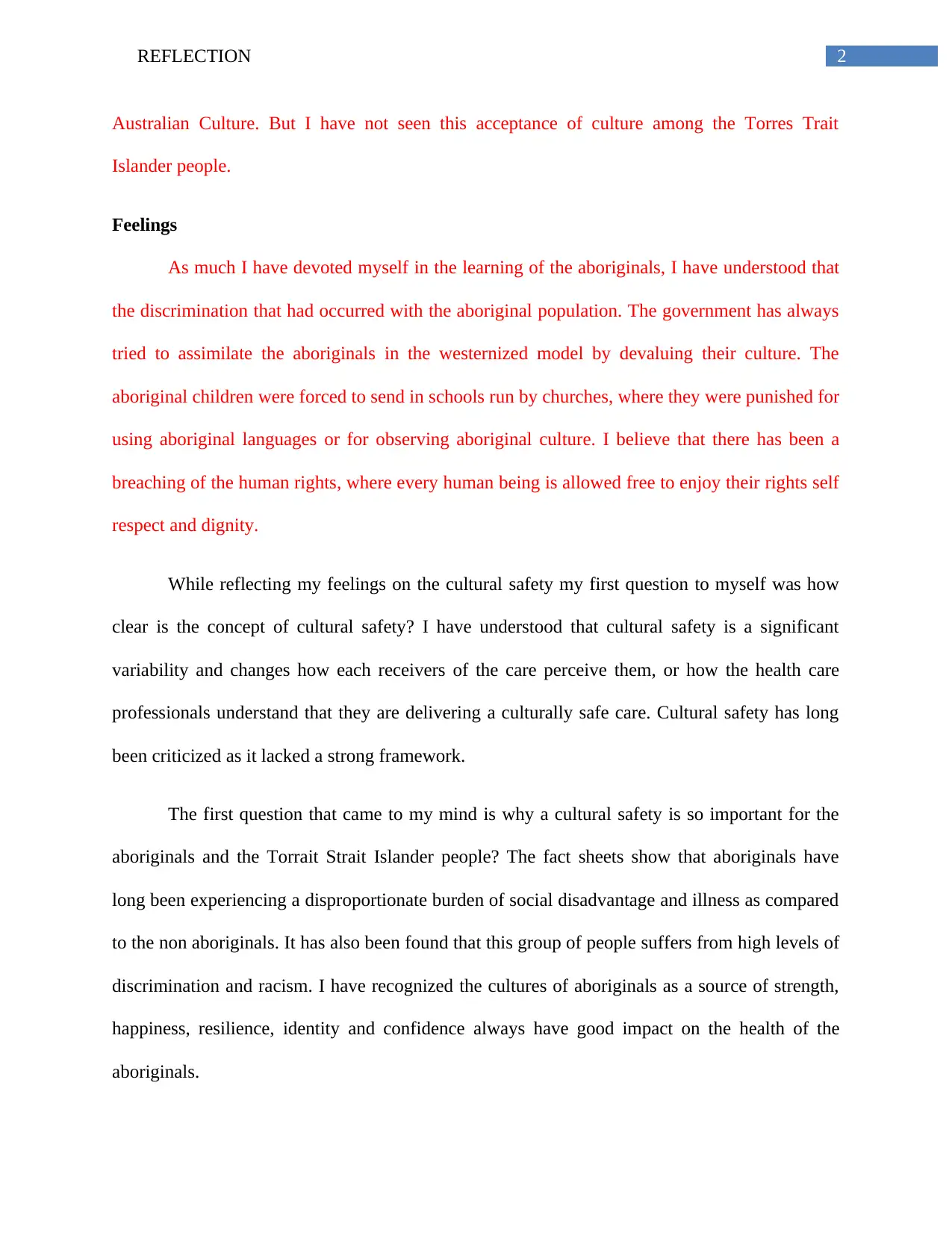
2REFLECTION
Australian Culture. But I have not seen this acceptance of culture among the Torres Trait
Islander people.
Feelings
As much I have devoted myself in the learning of the aboriginals, I have understood that
the discrimination that had occurred with the aboriginal population. The government has always
tried to assimilate the aboriginals in the westernized model by devaluing their culture. The
aboriginal children were forced to send in schools run by churches, where they were punished for
using aboriginal languages or for observing aboriginal culture. I believe that there has been a
breaching of the human rights, where every human being is allowed free to enjoy their rights self
respect and dignity.
While reflecting my feelings on the cultural safety my first question to myself was how
clear is the concept of cultural safety? I have understood that cultural safety is a significant
variability and changes how each receivers of the care perceive them, or how the health care
professionals understand that they are delivering a culturally safe care. Cultural safety has long
been criticized as it lacked a strong framework.
The first question that came to my mind is why a cultural safety is so important for the
aboriginals and the Torrait Strait Islander people? The fact sheets show that aboriginals have
long been experiencing a disproportionate burden of social disadvantage and illness as compared
to the non aboriginals. It has also been found that this group of people suffers from high levels of
discrimination and racism. I have recognized the cultures of aboriginals as a source of strength,
happiness, resilience, identity and confidence always have good impact on the health of the
aboriginals.
Australian Culture. But I have not seen this acceptance of culture among the Torres Trait
Islander people.
Feelings
As much I have devoted myself in the learning of the aboriginals, I have understood that
the discrimination that had occurred with the aboriginal population. The government has always
tried to assimilate the aboriginals in the westernized model by devaluing their culture. The
aboriginal children were forced to send in schools run by churches, where they were punished for
using aboriginal languages or for observing aboriginal culture. I believe that there has been a
breaching of the human rights, where every human being is allowed free to enjoy their rights self
respect and dignity.
While reflecting my feelings on the cultural safety my first question to myself was how
clear is the concept of cultural safety? I have understood that cultural safety is a significant
variability and changes how each receivers of the care perceive them, or how the health care
professionals understand that they are delivering a culturally safe care. Cultural safety has long
been criticized as it lacked a strong framework.
The first question that came to my mind is why a cultural safety is so important for the
aboriginals and the Torrait Strait Islander people? The fact sheets show that aboriginals have
long been experiencing a disproportionate burden of social disadvantage and illness as compared
to the non aboriginals. It has also been found that this group of people suffers from high levels of
discrimination and racism. I have recognized the cultures of aboriginals as a source of strength,
happiness, resilience, identity and confidence always have good impact on the health of the
aboriginals.
⊘ This is a preview!⊘
Do you want full access?
Subscribe today to unlock all pages.

Trusted by 1+ million students worldwide
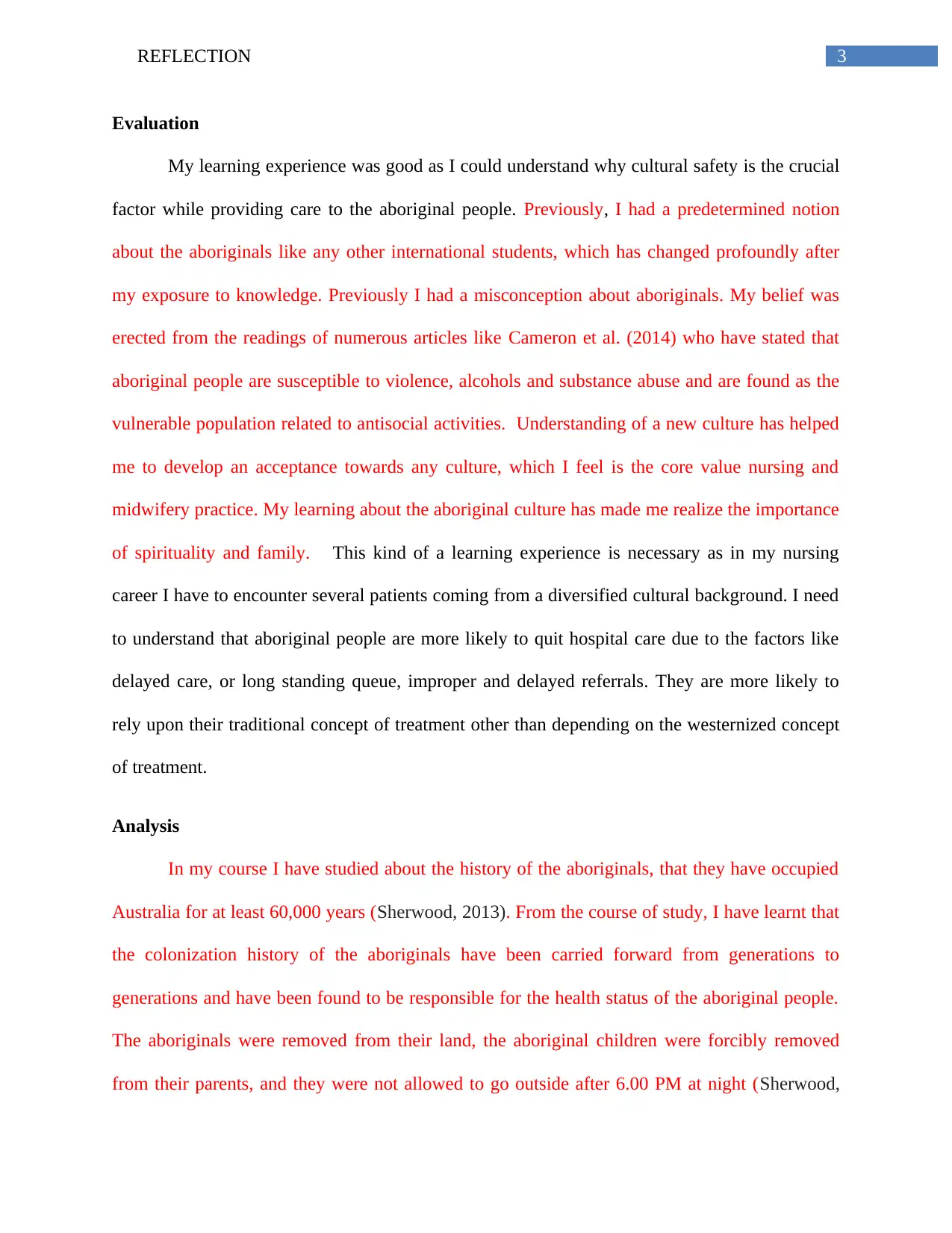
3REFLECTION
Evaluation
My learning experience was good as I could understand why cultural safety is the crucial
factor while providing care to the aboriginal people. Previously, I had a predetermined notion
about the aboriginals like any other international students, which has changed profoundly after
my exposure to knowledge. Previously I had a misconception about aboriginals. My belief was
erected from the readings of numerous articles like Cameron et al. (2014) who have stated that
aboriginal people are susceptible to violence, alcohols and substance abuse and are found as the
vulnerable population related to antisocial activities. Understanding of a new culture has helped
me to develop an acceptance towards any culture, which I feel is the core value nursing and
midwifery practice. My learning about the aboriginal culture has made me realize the importance
of spirituality and family. This kind of a learning experience is necessary as in my nursing
career I have to encounter several patients coming from a diversified cultural background. I need
to understand that aboriginal people are more likely to quit hospital care due to the factors like
delayed care, or long standing queue, improper and delayed referrals. They are more likely to
rely upon their traditional concept of treatment other than depending on the westernized concept
of treatment.
Analysis
In my course I have studied about the history of the aboriginals, that they have occupied
Australia for at least 60,000 years (Sherwood, 2013). From the course of study, I have learnt that
the colonization history of the aboriginals have been carried forward from generations to
generations and have been found to be responsible for the health status of the aboriginal people.
The aboriginals were removed from their land, the aboriginal children were forcibly removed
from their parents, and they were not allowed to go outside after 6.00 PM at night (Sherwood,
Evaluation
My learning experience was good as I could understand why cultural safety is the crucial
factor while providing care to the aboriginal people. Previously, I had a predetermined notion
about the aboriginals like any other international students, which has changed profoundly after
my exposure to knowledge. Previously I had a misconception about aboriginals. My belief was
erected from the readings of numerous articles like Cameron et al. (2014) who have stated that
aboriginal people are susceptible to violence, alcohols and substance abuse and are found as the
vulnerable population related to antisocial activities. Understanding of a new culture has helped
me to develop an acceptance towards any culture, which I feel is the core value nursing and
midwifery practice. My learning about the aboriginal culture has made me realize the importance
of spirituality and family. This kind of a learning experience is necessary as in my nursing
career I have to encounter several patients coming from a diversified cultural background. I need
to understand that aboriginal people are more likely to quit hospital care due to the factors like
delayed care, or long standing queue, improper and delayed referrals. They are more likely to
rely upon their traditional concept of treatment other than depending on the westernized concept
of treatment.
Analysis
In my course I have studied about the history of the aboriginals, that they have occupied
Australia for at least 60,000 years (Sherwood, 2013). From the course of study, I have learnt that
the colonization history of the aboriginals have been carried forward from generations to
generations and have been found to be responsible for the health status of the aboriginal people.
The aboriginals were removed from their land, the aboriginal children were forcibly removed
from their parents, and they were not allowed to go outside after 6.00 PM at night (Sherwood,
Paraphrase This Document
Need a fresh take? Get an instant paraphrase of this document with our AI Paraphraser
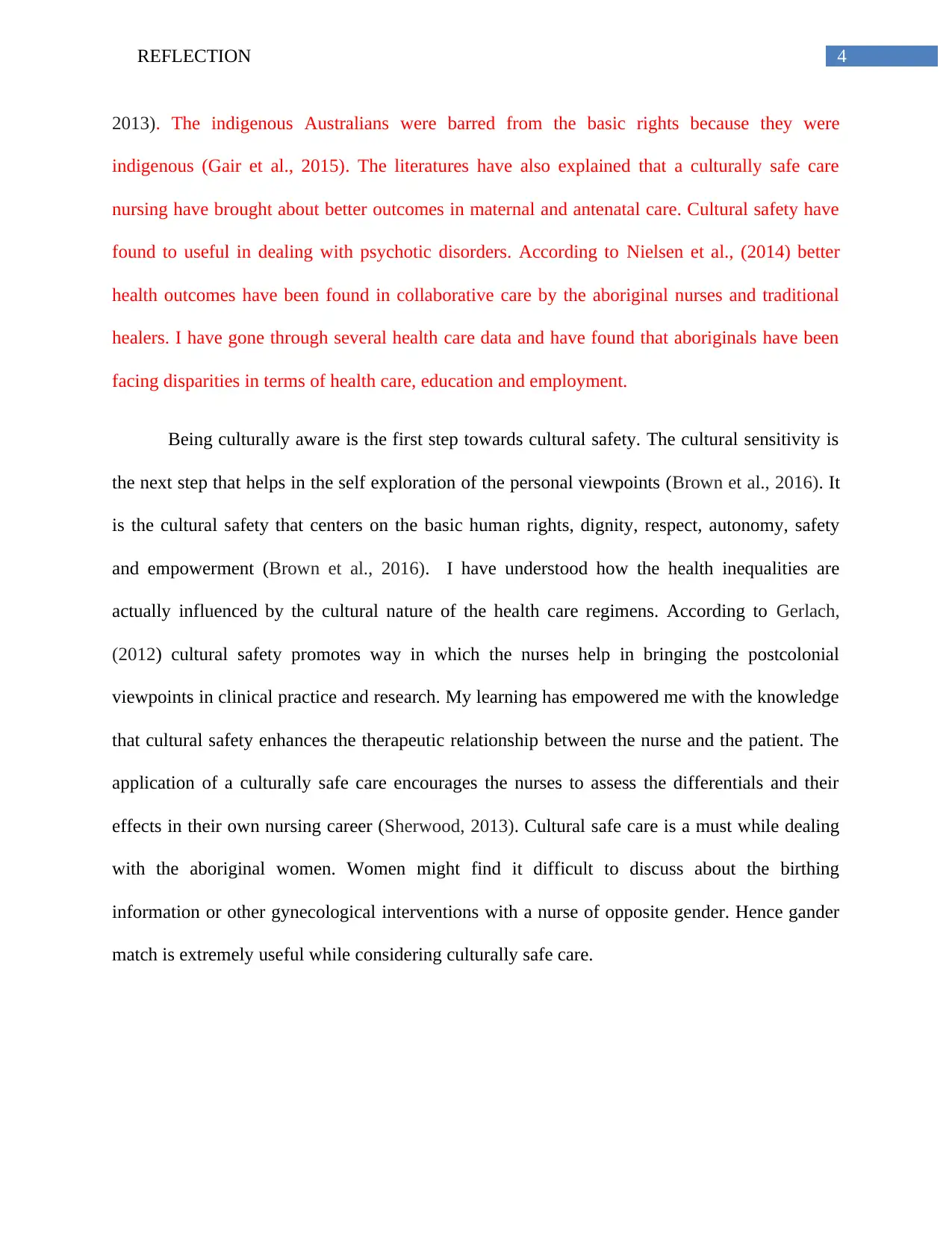
4REFLECTION
2013). The indigenous Australians were barred from the basic rights because they were
indigenous (Gair et al., 2015). The literatures have also explained that a culturally safe care
nursing have brought about better outcomes in maternal and antenatal care. Cultural safety have
found to useful in dealing with psychotic disorders. According to Nielsen et al., (2014) better
health outcomes have been found in collaborative care by the aboriginal nurses and traditional
healers. I have gone through several health care data and have found that aboriginals have been
facing disparities in terms of health care, education and employment.
Being culturally aware is the first step towards cultural safety. The cultural sensitivity is
the next step that helps in the self exploration of the personal viewpoints (Brown et al., 2016). It
is the cultural safety that centers on the basic human rights, dignity, respect, autonomy, safety
and empowerment (Brown et al., 2016). I have understood how the health inequalities are
actually influenced by the cultural nature of the health care regimens. According to Gerlach,
(2012) cultural safety promotes way in which the nurses help in bringing the postcolonial
viewpoints in clinical practice and research. My learning has empowered me with the knowledge
that cultural safety enhances the therapeutic relationship between the nurse and the patient. The
application of a culturally safe care encourages the nurses to assess the differentials and their
effects in their own nursing career (Sherwood, 2013). Cultural safe care is a must while dealing
with the aboriginal women. Women might find it difficult to discuss about the birthing
information or other gynecological interventions with a nurse of opposite gender. Hence gander
match is extremely useful while considering culturally safe care.
2013). The indigenous Australians were barred from the basic rights because they were
indigenous (Gair et al., 2015). The literatures have also explained that a culturally safe care
nursing have brought about better outcomes in maternal and antenatal care. Cultural safety have
found to useful in dealing with psychotic disorders. According to Nielsen et al., (2014) better
health outcomes have been found in collaborative care by the aboriginal nurses and traditional
healers. I have gone through several health care data and have found that aboriginals have been
facing disparities in terms of health care, education and employment.
Being culturally aware is the first step towards cultural safety. The cultural sensitivity is
the next step that helps in the self exploration of the personal viewpoints (Brown et al., 2016). It
is the cultural safety that centers on the basic human rights, dignity, respect, autonomy, safety
and empowerment (Brown et al., 2016). I have understood how the health inequalities are
actually influenced by the cultural nature of the health care regimens. According to Gerlach,
(2012) cultural safety promotes way in which the nurses help in bringing the postcolonial
viewpoints in clinical practice and research. My learning has empowered me with the knowledge
that cultural safety enhances the therapeutic relationship between the nurse and the patient. The
application of a culturally safe care encourages the nurses to assess the differentials and their
effects in their own nursing career (Sherwood, 2013). Cultural safe care is a must while dealing
with the aboriginal women. Women might find it difficult to discuss about the birthing
information or other gynecological interventions with a nurse of opposite gender. Hence gander
match is extremely useful while considering culturally safe care.
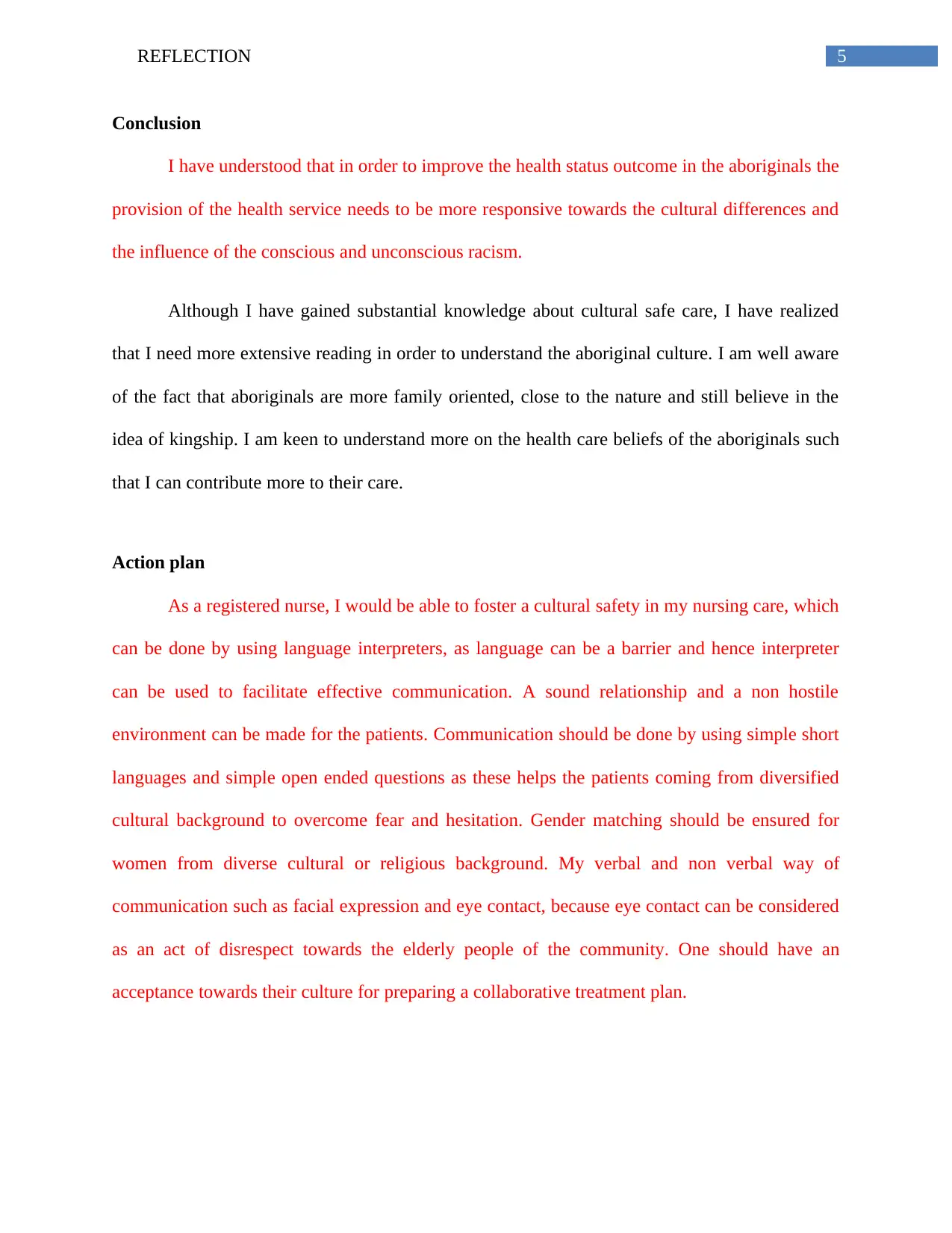
5REFLECTION
Conclusion
I have understood that in order to improve the health status outcome in the aboriginals the
provision of the health service needs to be more responsive towards the cultural differences and
the influence of the conscious and unconscious racism.
Although I have gained substantial knowledge about cultural safe care, I have realized
that I need more extensive reading in order to understand the aboriginal culture. I am well aware
of the fact that aboriginals are more family oriented, close to the nature and still believe in the
idea of kingship. I am keen to understand more on the health care beliefs of the aboriginals such
that I can contribute more to their care.
Action plan
As a registered nurse, I would be able to foster a cultural safety in my nursing care, which
can be done by using language interpreters, as language can be a barrier and hence interpreter
can be used to facilitate effective communication. A sound relationship and a non hostile
environment can be made for the patients. Communication should be done by using simple short
languages and simple open ended questions as these helps the patients coming from diversified
cultural background to overcome fear and hesitation. Gender matching should be ensured for
women from diverse cultural or religious background. My verbal and non verbal way of
communication such as facial expression and eye contact, because eye contact can be considered
as an act of disrespect towards the elderly people of the community. One should have an
acceptance towards their culture for preparing a collaborative treatment plan.
Conclusion
I have understood that in order to improve the health status outcome in the aboriginals the
provision of the health service needs to be more responsive towards the cultural differences and
the influence of the conscious and unconscious racism.
Although I have gained substantial knowledge about cultural safe care, I have realized
that I need more extensive reading in order to understand the aboriginal culture. I am well aware
of the fact that aboriginals are more family oriented, close to the nature and still believe in the
idea of kingship. I am keen to understand more on the health care beliefs of the aboriginals such
that I can contribute more to their care.
Action plan
As a registered nurse, I would be able to foster a cultural safety in my nursing care, which
can be done by using language interpreters, as language can be a barrier and hence interpreter
can be used to facilitate effective communication. A sound relationship and a non hostile
environment can be made for the patients. Communication should be done by using simple short
languages and simple open ended questions as these helps the patients coming from diversified
cultural background to overcome fear and hesitation. Gender matching should be ensured for
women from diverse cultural or religious background. My verbal and non verbal way of
communication such as facial expression and eye contact, because eye contact can be considered
as an act of disrespect towards the elderly people of the community. One should have an
acceptance towards their culture for preparing a collaborative treatment plan.
⊘ This is a preview!⊘
Do you want full access?
Subscribe today to unlock all pages.

Trusted by 1+ million students worldwide
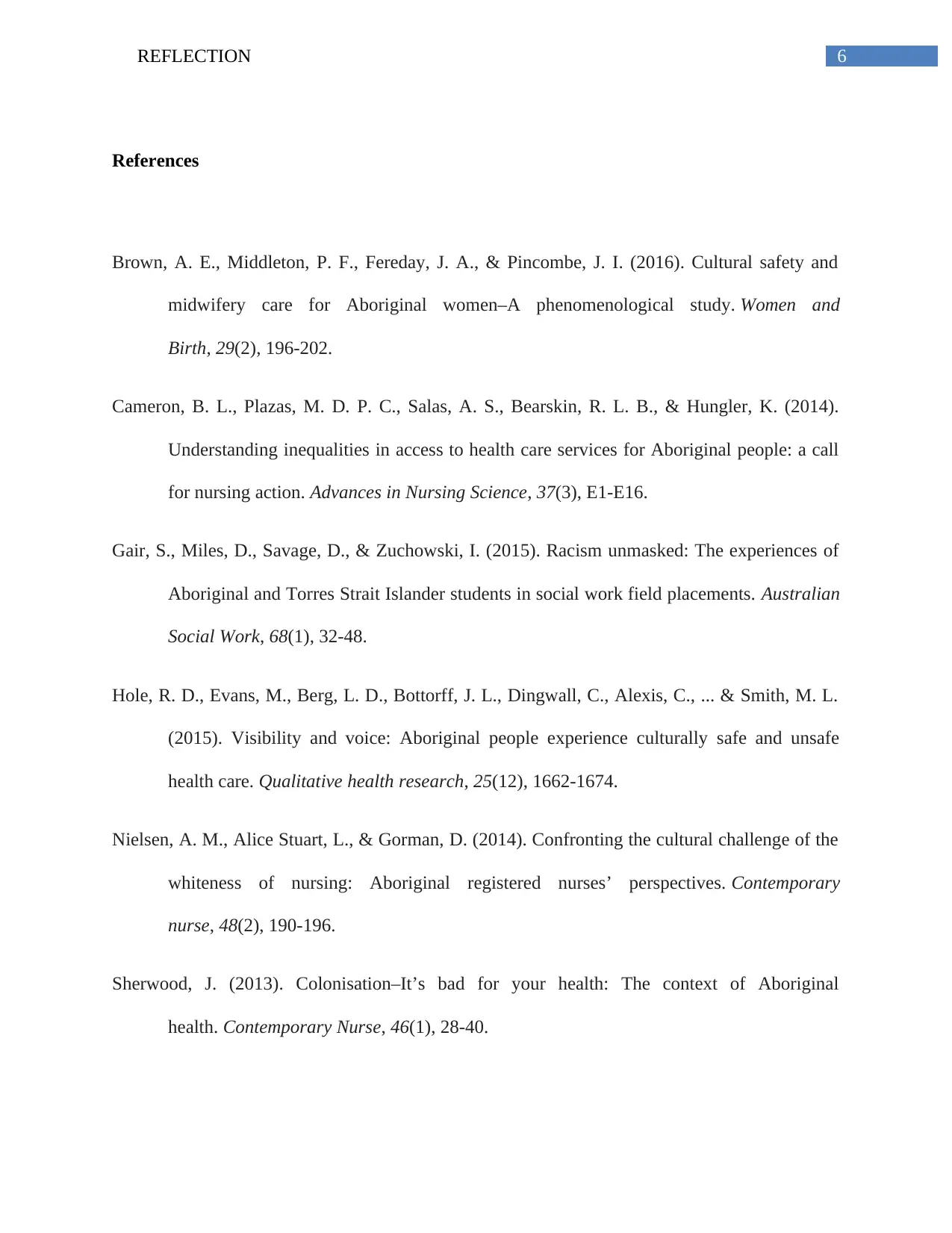
6REFLECTION
References
Brown, A. E., Middleton, P. F., Fereday, J. A., & Pincombe, J. I. (2016). Cultural safety and
midwifery care for Aboriginal women–A phenomenological study. Women and
Birth, 29(2), 196-202.
Cameron, B. L., Plazas, M. D. P. C., Salas, A. S., Bearskin, R. L. B., & Hungler, K. (2014).
Understanding inequalities in access to health care services for Aboriginal people: a call
for nursing action. Advances in Nursing Science, 37(3), E1-E16.
Gair, S., Miles, D., Savage, D., & Zuchowski, I. (2015). Racism unmasked: The experiences of
Aboriginal and Torres Strait Islander students in social work field placements. Australian
Social Work, 68(1), 32-48.
Hole, R. D., Evans, M., Berg, L. D., Bottorff, J. L., Dingwall, C., Alexis, C., ... & Smith, M. L.
(2015). Visibility and voice: Aboriginal people experience culturally safe and unsafe
health care. Qualitative health research, 25(12), 1662-1674.
Nielsen, A. M., Alice Stuart, L., & Gorman, D. (2014). Confronting the cultural challenge of the
whiteness of nursing: Aboriginal registered nurses’ perspectives. Contemporary
nurse, 48(2), 190-196.
Sherwood, J. (2013). Colonisation–It’s bad for your health: The context of Aboriginal
health. Contemporary Nurse, 46(1), 28-40.
References
Brown, A. E., Middleton, P. F., Fereday, J. A., & Pincombe, J. I. (2016). Cultural safety and
midwifery care for Aboriginal women–A phenomenological study. Women and
Birth, 29(2), 196-202.
Cameron, B. L., Plazas, M. D. P. C., Salas, A. S., Bearskin, R. L. B., & Hungler, K. (2014).
Understanding inequalities in access to health care services for Aboriginal people: a call
for nursing action. Advances in Nursing Science, 37(3), E1-E16.
Gair, S., Miles, D., Savage, D., & Zuchowski, I. (2015). Racism unmasked: The experiences of
Aboriginal and Torres Strait Islander students in social work field placements. Australian
Social Work, 68(1), 32-48.
Hole, R. D., Evans, M., Berg, L. D., Bottorff, J. L., Dingwall, C., Alexis, C., ... & Smith, M. L.
(2015). Visibility and voice: Aboriginal people experience culturally safe and unsafe
health care. Qualitative health research, 25(12), 1662-1674.
Nielsen, A. M., Alice Stuart, L., & Gorman, D. (2014). Confronting the cultural challenge of the
whiteness of nursing: Aboriginal registered nurses’ perspectives. Contemporary
nurse, 48(2), 190-196.
Sherwood, J. (2013). Colonisation–It’s bad for your health: The context of Aboriginal
health. Contemporary Nurse, 46(1), 28-40.
Paraphrase This Document
Need a fresh take? Get an instant paraphrase of this document with our AI Paraphraser

7REFLECTION
1 out of 8
Related Documents
Your All-in-One AI-Powered Toolkit for Academic Success.
+13062052269
info@desklib.com
Available 24*7 on WhatsApp / Email
![[object Object]](/_next/static/media/star-bottom.7253800d.svg)
Unlock your academic potential
Copyright © 2020–2025 A2Z Services. All Rights Reserved. Developed and managed by ZUCOL.





